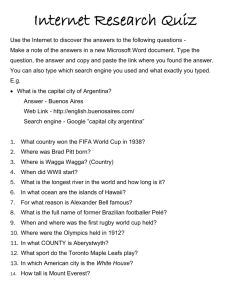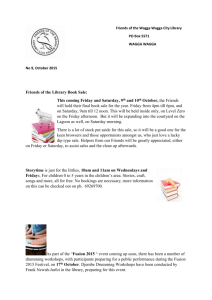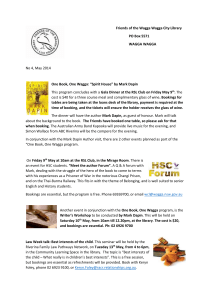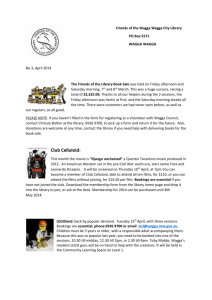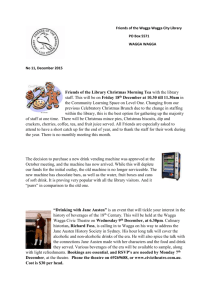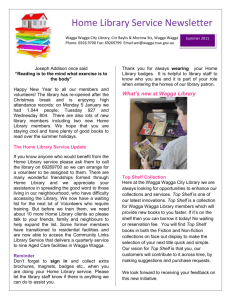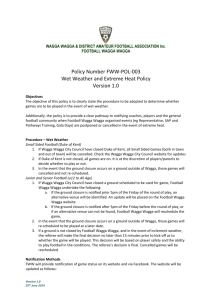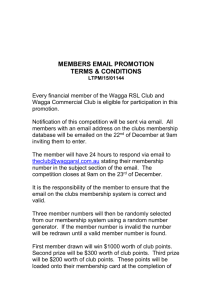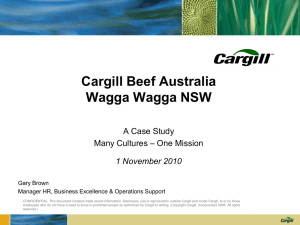“Serving our King and Country”
advertisement
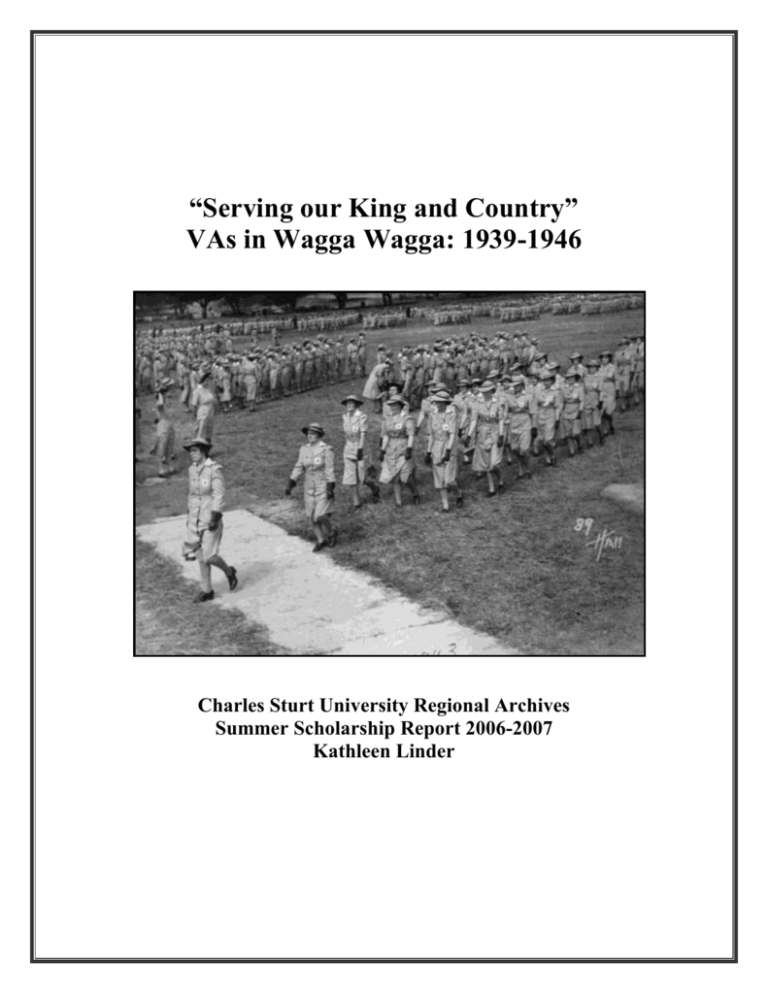
“Serving our King and Country” VAs in Wagga Wagga: 1939-1946 Charles Sturt University Regional Archives Summer Scholarship Report 2006-2007 Kathleen Linder “Serving our King and Country” VAs in Wagga Wagga: 1939 - 1946 “Serving our King and Country” VAs in Wagga Wagga: 1939-1946 Charles Sturt University Regional Archives Summer Scholarship Report 2006-2007 Kathleen Linder This report is a written and photographic* history of the Wagga Wagga Red Cross Voluntary Aid Detachment (VAD) between 1939 and 1946 – the period it was under the command of Mrs Doreen Erskine (nee Fraser, later Hutchinson). During and after this period, Erskine collected documents, clippings, photographs and memorabilia relating to her time in the detachment. Later she compiled these into a scrapbook, which although unorganised and poorly referenced, provides a comprehensive and valuable historiography of the Wagga Wagga VAD. The scrapbook is annotated in both first and third person and gives Mrs Erskine’s interpretation of the history of the VAD in Wagga Wagga. In some instances the comments are personal reflections on her time as Commandant, while other comments provide an outside commentary during which she even refers to herself in the third person. This scrapbook, as well as the Wagga Wagga VAD Annual Reports for the period (also collected by Erskine) are the major primary sources for this report. These resources, which capture a snapshot of life during the early 1940s for members of the detachment, are held in the Charles Sturt University Regional Archives, Wagga Wagga (RW1647). Melanie Oppenheimer’s Red Cross VAs: A History of the VAD Movement in New South Wales was another essential resource, providing important state and national background information on Voluntary Aid Detachments, especially during the World War II period. * Captions in quotation marks are quotes made by Erskine accompanying the photograph in her scrapbook. All photographs can be found in the VAD collection in the CSU Regional Archives Wagga Wagga (RW1647). 2 “Serving our King and Country” VAs in Wagga Wagga: 1939 - 1946 Introduction On August 25 1939, Britain and Poland signed a treaty of mutual assistance. Seven days after this on September 1st the German Army invaded Poland, two days later, Britain and France declared war on Nazi Germany. Less than two hours later, Menzies announced Australia’s support of Britain and its involvement in the war.1 There remained a loyalty to Britain in Australia, reflected by Menzies’ political values, and proved by his swift response to declare Australia’s support of Britain in the newly declared war.2 The war was not a surprise to the people of Australia, having been warned since 1938 of the crisis in Europe through the media.3 The city of Wagga Wagga was a major centre for the Australian military during World War II, to the extent that Morris refers to it as becoming “almost a garrison town.”4 Royal Australian Air Force (RAAF) bases were established at Forest Hill and Uranquinty, while an Australian Imperial Force (AIF) base was established at the Wagga Showgrounds. Numerous organisations supported the military forces stationed in Wagga Wagga. These included: the Returned Sailors, Soldiers and Airmen Imperial League of Australia (RSSAILA) who later formed the Voluntary Defence Corps , the Wagga Wagga and District Mayor’s Patriotic and War Fund, the Country Women’s Association , the RSSAILA Women’s Auxiliary, and the Red Cross Society with its auxiliary unit - the Wagga Wagga Voluntary Aid Detachment (VAD)5. The Wagga Wagga VAD was strong “Inspection by Lady Wakehurst – Many girls not yet in uniform” 3 “Serving our King and Country” VAs in Wagga Wagga: 1939 - 1946 and valuable with 143 members in total over the World War II period.6 It was a military based organisation carrying out medical assistance at the various military camps and bases as well as Wagga Wagga hospitals (including the public Wagga base hospital Wagga Wagga “VAD sports day at cricket ground” and the private hospitals, Welwyn and Lewisham). They were also active in non-medical voluntary activities and in fundraising, with most proceeds going to the Australian Red Cross Society. Due to the military nature of Voluntary Aid Detachments, VAs were targeted for recruitment when women were enlisted into the army and later when the Australian Army Medical Women’s Service (AAMWS) was established. The Wagga Wagga Detachment was at its strongest during World War II, under the command of Mrs Doreen Erskine, though membership declined towards 1945 and the detachment ceased operating in 1948. While not operating in Wagga Wagga until 1939, VADs had been active in NSW since the beginning of World War I, carrying out menial but essential tasks in hospitals and convalescent homes throughout the state.7 Subsidiary to nurses due to their lack of registered medical qualifications, VAs worked under supervision and were most useful in assisting qualified medics, forming a productive team for the improvement of work in hospitals. NSW VAD membership peaked during wartime, reaching 3500 by the end of World War I in 1918. During the inter-war period (1919 – 1938), numbers dropped to as low as 100 in 1930-36 before increasing to 927 members by 1938, and to 5150 members in 1939.8 It was at this time that many VADs re-formed and new VADs were established, such as the Wagga Wagga 4 “Serving our King and Country” VAs in Wagga Wagga: 1939 - 1946 Detachment. Membership in Wagga Wagga peaked in 1942 with 84 active members. This was, and still is, a record for VAD memberships in country NSW.9 Urgent Beginnings: September 1939 On September 14, 1939, eleven days after the declaration of war, Wagga Wagga Mayor, Henry Gissing called a public meeting. At this meeting, Mr G. C. Graham, Commissioner of the New South Wales branch of the Red Cross, gave an address stating that Wagga Wagga was one of “10 key cities in the government’s defence plan, and that it was expected A.I.F. military training would be carried out in Wagga.” The meeting led to the Wagga Wagga Red Cross Branch being placed on a war footing, and the formation of a Voluntary Aid Detachment (VAD). The meeting saw 40 women volunteer to join the detachment.10 The following women were provisionally elected to the Voluntary Aid Detachment official positions: Mrs Doreen Erskine as Commandant, Miss J. Rentoul as Assistant Commandant, and Miss Bessie Wunsch as Quartermaster. By October 29, the first General Annual Meeting, Rentoul had left the detachment and the position of Assistant Commandant had been taken over by Miss H. Milne.11 These initial three young women (Erskine, Wunsch and Milne) would provide several years of invaluable service to the VAD during the World War II period.12 As Commandant of the Wagga VAD, Mrs Doreen Erskine ensured its efficiency and value within the community. Voluntary Aid Detachment Wagga Wagga The Wagga Wagga Voluntary Aid Detachment (VAD) had a number of elements that contributed to the nature of the organisation, such as State VAD ideology and policy. On 5 “Serving our King and Country” VAs in Wagga Wagga: 1939 - 1946 September 22 the first meeting of the Wagga Wagga VAD was held in St John’s Hall, Baylis Street, where 70 women attended.13 Derived from State VAD regulations, the Detachment upheld the following aims, objectives and regulations in 1940: The Aims and Objectives of a Red Cross Voluntary Aid Detachment are to have a trained body of women who can take their place amongst sickness or accidents in time of peace or war and in times of crisis to give assistance in hospitals. They are a branch of the Army Service Medical Corps and are controlled by the Joint State Council of VAD Victoria Barracks, Sydney. Annual Membership fee is 2/- and girls are to supply their own uniforms Meetings are held each Wednesday night at the Drill Hall. Detachment consists of three officers and section leaders of each group consisting of 12 or 15 girls. Girls are expected to attend parades each week in uniform, to show loyalty to their leaders, and to remember they wear a uniform that they have every reason to be proud of. A certain amount of drill has to be done to instil into members the necessity for discipline and instant obedience to orders.14 These regulations established the official nature of the VAD, providing guidelines that ensured a solid ideology and purpose. Also, it developed a sense of pride, discipline and structure. Contributing to the ideology of the VAD was its motto: “Honour to God, Loyalty to the King, Faithful service to the Sick and Wounded.” The detachment was divided into between two and five sections depending on membership numbers. Section Leaders played an important role in organising members, inspiring good work and discipline, and ensuring the well-being of the members in their section. Members appointed as Section Leaders were often the most involved women in the Detachment. Miss H. Milne, for example, was Assistant Commandant for four years, a 6 “Serving our King and Country” VAs in Wagga Wagga: 1939 - 1946 Section Leader for two years, and Secretary and Treasurer of the war savings group of the VAD for three years. Many VAD section leaders were unmarried and without children, and hence there was a trend of these women enlisting in the army, and later the Australian Army Medical Women’s Service (AAMWS) (see page 20). Thus, Section Leaders often changed from year to year, allowing for a great number of women to have experience in leadership roles. There was diversity among members in terms of their occupations, age and marital status. Members of the Wagga Wagga VAD were women from the Wagga Wagga area who carried out different occupations some of which included; domestic work, office work, sewing, sales and teaching.15 Mrs Doreen Erskine was the only trained nurse in the Detachment during the World War II period, also there was an optician’s assistant and a dental assistant who became members. 16 Women who worked during the day in their various occupations assisted the VAD during evenings and on weekends.17 There is a question as to the motivations women had for joining the VAD, especially those who had part-time or fulltime employment as well as domestic duties. It is impossible to discover each woman’s reasons for joining the VAD over other voluntary organisations, one may only speculate. Women were keen to contribute to the war effort; this is evident through the amount of community provided. support Many they women would have had brothers, friends and partners who were enlisted in the armed forces and may have felt Counter marching display at Wagga Wagga Showgrounds September 25t 1940 7 “Serving our King and Country” VAs in Wagga Wagga: 1939 - 1946 obligated to serve their country during the war. The VAD was a way for women in Wagga to do this in their hometown. There is evidence of families having both men in the Military and women associated with the VAD. Younger sisters often followed their older sisters into the VAD, the Doubledays, Laitys, and Angels were families with two or more sisters in the detachment. Other women may have joined the VAD to pursue an interest in the medical profession or an interest in learning new skills. “Assembly for a street march” 8 “Serving our King and Country” VAs in Wagga Wagga: 1939 - 1946 Commandant Erskine “My work and association with the Voluntary Aid Detachment was the most rewarding years of my life.” 9 “Serving our King and Country” VAs in Wagga Wagga: 1939 - 1946 Before the outbreak of war, Mrs Doreen Erskine had completed her training in nursing, graduating in 1927.18 Two years later at 23 years of age, she married Joseph Erskine a 49-year-old retired farmer.19 Soon after her marriage, she gave birth to her only child, a daughter whom the couple named Jean. Jean Erskine was a young teenager during World War II and grew up around the activities and members of the VAD. Throughout the scrapbook, there are small hints of Jean’s presence at VAD activities. These include her Mrs Doreen Erskine – VAD Commandant name on the VAD membership book and an immature signature on a Christmas card for Doreen signed by all the members of the Detachment.20 It is likely that the young women around Jean accepted her as a kind of honorary member of the VAD. Along with her family commitments during the period 1929 to 1939, Erskine contributed to many charitable and community organisations and later worked with Mick Loth, Superintendent of the Wagga Wagga District Ambulance Service, lecturing first aid and home nursing to hundreds of residents in Wagga and surrounding areas.21 Commandant of the Wagga Wagga Voluntary Aid Detachment throughout the World War II period, her appointment as such most likely due to her background in teaching first aid and home nursing and her qualifications as a trained nurse. As Commandant of the Wagga Wagga VAD she demonstrated natural leadership skills that are apparent in all her life’s work. She was the leading figure for the Detachment, devoting herself to the maintenance of, and the efficiency and value of the work carried out by the detachment. Throughout the years of 10 “Serving our King and Country” VAs in Wagga Wagga: 1939 - 1946 VAD operation during the early 1940s, the strength and significance of the Detachment’s role in the Wagga Wagga area mirrored her inspiring leadership. A Military Style Operation Voluntary Aid Detachments (VADs) were a regimented organisation, based on traditional military concepts such as rank, service to one’s country, and taking orders. The way VADs functioned was influenced by the nature of their work and the ideology of their membership. Before the declaration of war, in August 1938, the Australian Military Forces’ Military Board had outlined a policy pertaining to the role of “philanthropic funds” in the event of the outbreak of a war. They were to work in areas of soldier morale, recreational activities, and to tend the sick and wounded.22 The organisations that this policy was to relate to were; the Australian Comforts Fund, The Australian Red Cross Society (including VADs), the Salvation Army, and the Young Men’s (and later Women’s) Christian Association (YMCA, YWCA).23 VADs already fulfilled these requirements and to improve, they would only have to increase membership and hence the extent of their work. This policy however did not have a great impact on the nature of VADs as their military style organisation dated to their formation during World War I, with ranks such as Commandant, Assistant Commandant and Quartermaster, as well as Section Leaders and their deputies.24 The military nature of VAD units increased with a change in the VAs uniform in 1940. The dresses worn changed from white Marching at Wagga Wagga Showgrounds: Note Different Uniforms. September 1940 to blue, with lighter blue for summer uniforms 11 “Serving our King and Country” VAs in Wagga Wagga: 1939 - 1946 and navy blue for winter. This change created a clear distinction between VAs and nurses, where previously the only difference had been the presence of a small red cross on the front pocket of the VAD uniform (which remained on the new uniform).25 It took the Wagga Wagga VAD unit about six months for all members to change to their new uniforms. (Members in the photo on page 11 are seen wearing both the old and new style of uniform). The Commandant, Assistant Commandant and Quartermaster were identifiable by strips on their shoulder, silver buttons, and long sleeves. This, and a badge with the detachment number (number 223 for the Wagga Wagga Detachment) worn on the left hand pocket, also contributed to the military style of the uniform. Thus, the Wagga Wagga VAD looked like (and were) an efficient, regimented and highly organised unit and matched that of AIF and RAAF units marching along side them on the Wagga Wagga Showground Military Base and on Fitzmaurice Street processions towards the Cenotaph. Soldiers and VAs march on Fitzmaurice Street: October 5th 1940 Despite the VAD’s success, the military nature of the VAD would have been foreign to women in the organisation. (Their previously mentioned occupations suggest this). However, drills, marching, ranks, sections and the uniform had their benefits. A disciplined and well-organised structure assisted in their work with those in the military through their ability to take orders from those in public, military and private hospitals while also assisting 12 “Serving our King and Country” VAs in Wagga Wagga: 1939 - 1946 in their understanding of military constructs. For the Wagga Wagga VAD the success of their work at the Showground military hospital (see pages 15-16) can be drawn back to not only their useful skills and keen, energetic labour, but also their pride in assisting the war effort and the increased connection between this pride and their serious military nature. When, after less than two months of operation Red Cross Commissioner, Mr Graham, inspected the detachment, he described them as being “100 percent efficient.”26 The VAD was constantly commended on their “splendid appearance”27 while marching in military processions, such as those held on Anzac Day. The Wagga Wagga VAD had many inspections by those in the military, Red Cross and city council, including Thomas Blamey, the highest ranked officer from Wagga Wagga during both World War I and II.28 All inspections of the Detachment reported that the women were well presented, efficient, and were doing good work. 29 This feedback was to the credit of the officers, Section Leaders and girls, with Erskine regularly informing the girls and the Wagga Wagga community of the positive comments through annual reports and the Daily Advertiser. “Faithful service to the sick and wounded” To become valuable to the military and the Wagga Wagga community the VAs had to become skilled in the medical field. The women achieved this through determined training, lectures and first-hand experience. Erskine was persistent and passionate about the education of Service as Ambulance Drivers: Early 1940s “her girls”, ensuring her VAD would become a 13 “Serving our King and Country” VAs in Wagga Wagga: 1939 - 1946 valuable asset in the Wagga Wagga area. From the first few months of the establishment of the Wagga Wagga VAD the members gained first hand experience at the Wagga Wagga Base Hospital. In May 1940, first aid lectures began, with examinations being held in September that “A.I.F. Camp Hospital at Showground: 1940-1941” year. Essential to the services the VAD would later provide, their various educational activities included; lectures in first aid, home nursing, camp hygiene, and dangerous gasses.30 Superintendent Mick Loth of the Wagga Wagga District Ambulance Service ran the first aid lectures, with Erskine lecturing home nursing. Training and examinations continued throughout the World War II period to increase members’ qualifications and to train new members in essential skills. Early in 1940, the first competitions for the Field Efficiency Cup and the General Efficiency Cup were carried out. They tested the knowledge and skills the detachment had developed since their formation, including drill work, counter-marching, first aid and home nursing.31 These competitions continued throughout the years Erskine was Commandant, and created a positive rivalry between sections of the Detachment. This contributed to the members’ enthusiasm to improve their skills. Out of 84 girls to sit their First Aid Examination in the September 1940, 78 passed their examinations and gained their qualifications.32 Home nursing subjects were complex and diverse and included; “qualifications of a good nurse, the sick room, care of the patient, observation of patients, types of temperatures and how to reduce temperatures, pulse and respiration, disinfectants, medicines, bed sores, infectious diseases, inflammation, child birth, sterilisation, and definitions of numerous medical terms.”33 The skills gained from 14 “Serving our King and Country” VAs in Wagga Wagga: 1939 - 1946 these subjects would allow the women to be more competent when working with medical professionals. Using the above education VAs could carry out a number of different tasks that were extremely helpful to many in the Wagga Wagga Region. The VAD assisted at the RAAF bases at Uranquinty and Forest Hill, as well as, and most commonly in the early years of the detachment, at the AIF 54th “In Supper room, Kyeamba-Smith Hall – beds loaned from towns folk” Battalion and the 21st Light Horse Regiment camps at the Wagga Wagga Showground, which was established in June 1940.34 The first practical medical activity the VAs assisted with was preparing and dressing the arms of some 2000 recruits for vaccinations. This impressive feat, for an organisation only 9 months into its operation, is an example of the menial, yet essential work the VAD carried out to improve medical services during World War II. Once the hospital at the showgrounds had been established with VA assistance, they were able to carry out medical duties under the supervision of a trained nurse. Between the July 19 and October 29 1940, 374 patients were attended to by VAD members.35 VAs assisted with preparing arms for another 2000 vaccinations in September for typhoid. In 1941, VAs assisted with blood-grouping, vaccinating, and inoculating hundreds more men and assisted with the opening of an X-Ray plant at the Wagga Wagga Base Hospital. Mentioned also in the 1941 VAD annual report is an outbreak of influenza at the RAAF base in Uranquinty, which the VAs also assisted in managing.36 This essential work for the military organisations would have been both dangerous due to the infectious nature of the condition and extremely unglamorous, defining 15 “Serving our King and Country” VAs in Wagga Wagga: 1939 - 1946 the VAD as not only a respectable organisation with high community status, but one that carried out valuable work on the home front, and so, earning their good reputation. VAs also cared for sick airwomen at the WAAAF Headquarters in Wagga Wagga. Lieutenant Colonel K. N. Rogers-Harrison of the 21st Australian Reece Battalion who was stationed at the Wagga Showground camp wrote to Erskine: I hope you will accept my very grateful thanks for the wonderful work you and your detachment did for my unit during our long stay in Wagga. Every member of the regiment will always carry with him very happy recollections of you and your assistants as well as a deep sense of gratitude.37 Just one of the many compliments given to the Detachment for their work, Rogers-Harrison’s comments of praise and appreciation reflect the importance of the VAs work and the efficient way in which it was carried out. It is clear that the medical activities carried out by the VAD were impressive, exceptionally useful within local and military medical institutions, and also were carried out efficiently. “Placing wreath on Cenotaph: D. Erskine. Left – Sir Thomas Blamey on visit to Wagga Wagga Right – The Mayor – Alderman H. Gissing” 16 “Serving our King and Country” VAs in Wagga Wagga: 1939 - 1946 Social and Cultural Improvement The Wagga Wagga Voluntary Aid Detachment (VAD) provided volunteer work in other areas. Their first opportunity to carry out work as a group came when military authorities requested that the girls help with typing and shorthand writing at the Drill Hall while the recruiting process was being carried out. Also, and quite impressively, 22 VAs worked to produce 2,100 sandwiches in less than 3 hours for 700 army soldiers and personnel travelling to Sydney by train in July of 1940.38 Interested in increasing their skills and making themselves more helpful, some VAs undertook training in driving trucks. At the Wagga Wagga Base Hospital the VAs helped with the marking of linen, sealing jam, and producing soap, jam, pickles and sauces for use in the hospital. A group associated with the Wagga Wagga Voluntary Aid Detachment endearingly referred to as “Our VAD Auxiliary” by VAD members worked to produce large quantities of medical supplies.39 The Wagga Wagga VAD carried out extensive fundraising efforts with the majority of their proceeds going to the Red Cross. Included in the efforts were market days, street stalls, drill and counter marching demonstrations, annual balls and regular dances.40 Throughout the war period 3000 woollen VAD dolls were made by VAs and sold at 1 shilling each, providing £150 for the Red Cross.41 An event named the VA Digger’s Queen Competition was held in 1941, with VA member Dolly Walker being dubbed “Digger’s Queen”42. A War Savings Group was established with Miss H. Milne carrying out the secretarial and treasurer roles. This established group, Red Cross VA Dolls 3000 made in 1941 in July 1940, 17 “Serving our King and Country” VAs in Wagga Wagga: 1939 - 1946 had purchased 313 £1 certificates by November 1943. The Wagga VAD also raised funds for the Mayor’s Patriotic and War Fund and the Australian Comforts Fund, along with other local organisations. The fundraising efforts by the VAD contributed to the impressive amount £1,140,008 raised by the Wagga of Wagga Digger’s Queen Competition 1941 Municipality and Kyeamba and Mitchell shires during World War II.43 The Women of the VAD Women in the VAD were interesting, fun-loving characters carrying out many entertaining and amusing activities complementing their serious voluntary work. In September 1945, the first edition of “The Capelline” was published. It was named after the capeline bandage which, applied like a cap was used for protecting the head, shoulder or ‘stump’ after amputation. This newsletter was a humorous piece of work that included articles, poems, stories and advertisement parodies. The style of publication was original to the Wagga Wagga Detachment with its invention discussed in the first edition. It was written and published, using typewriters and carbon paper to make copies, by three VAs who referred to themselves as “we three” or the “three wise girls.” Their pseudonyms were Sally Saline, Olive Oil, and Annie Enema, with articles also authored by Brucie Bandage, and the “gossip” section by Katty Korner. Percy Pain had the title of Business Manager.44 Below is a parody of an advertisement found in the October 1945 edition of “The Cappeline” as an example of 18 “Serving our King and Country” VAs in Wagga Wagga: 1939 - 1946 the humorous publication produced by the VAs (further examples are included as Appendix A). OUR ADVERTISING SECTION Does your Boy-friend cringe and shudder when you get within a couple of yards of him? Do your Pals in your Section shun you? If so, you are the victim of the DREADED DISEASE: of Bolonyosis. Send at once for a quart bottle of our Marvellous new Discovery “Dinkum Oil” Guaranteed to cure: - Bolonyosis, Section Leader’s Throat, Everett Itch, House-maid’s Knee, Prickle Heat, Night Starvation, Flat Feet, Swollen Head, Sunburn, Heartburn, Ingleburn, Ingrowing Toenails, Kapooka Throat, Heartbreak, and any other ailment you happen to be suffering from.45 The three officers: Mrs Doreen Erskine, Mrs Doris Driver and Mrs Doris Oliver were nicknamed Dizzy, Dingle, and Dangle by the editors of “The Capelline.” The fondness for these leaders, as demonstrated by the newsletter, reveals the type of caring and friendly yet responsible leadership carried out by the women. Mrs “Dizzy” Erskine in December 1945 used the newsletter to pass on her congratulations, thanks, and good wishes to the VAs, marking the end of the year, and her acknowledgment of the “close of hostilities.” In her message, she states; “I have loved the companionship, confidence, and loyalty of the girls over all the years, and the time spent with you will always be something to be proud of.”46 This and a comment made in her scrapbook; “My work and association with (the) Voluntary 19 “Serving our King and Country” VAs in Wagga Wagga: 1939 - 1946 Aid Detachment – the most rewarding years of my life” demonstrates Erskine’s devotion and pride for the VAD and the girls under her command.47 The numerous reunions are evidence for the lifelong friendships and rewarding work the VAD provided for the women involved.48 VAD Recruits – The Army and AAWMS Forty-one members of the Wagga Wagga VAD enlisted in the Armed Forces during World War II. Following a decision made by Red Cross and VAD officials in February 1941, VAs across the country were to nominate if they were available for service. Women available for service were categorised as “Active,” and had to be unmarried, between the ages of 21 and 40, and healthy. Those who did not fall into this group were categorised as “Reserve.”49 Many women in this “active” list enlisted in the Army, however were still recognised as VAs.50 Nineteen VAs from Wagga enlisted into the Armed Services under their original VA title. In December 1942, the Australian Army Medical Women’s Service (AAMWS) was created. It was to become a force of women available to assist in hospitals and on bases in Australia and overseas. Many women already in the medical field within the Army became part of the AAMWS and forfeiting their VA title. Most of the nineteen women enlisted prior to the creation of the AAMWS would have become part of the new Jean McIntyre: AAMWS service. There were twenty-two VA recruits from 20 “Serving our King and Country” VAs in Wagga Wagga: 1939 - 1946 Wagga Wagga enlisted directly into the AAMWS.51 While the enlistment of women into the AAMWS meant the decline in membership of the VAD, it provided the groundwork for skilled and enthusiastic women entering the Army. Local efforts decreased due to this decline in membership, however it was replaced by fulltime, paid female labour for the war effort. Forty-one girls were in uniform serving their country on the home front and overseas, where their skills were needed – probably more than they were needed locally by 1943 onwards. Members of the Wagga Wagga VAD were proud of the fact that their initial training and work was VAD Roll of Honour. Presented 1943 “A proud moment for Commandant Erskine” acknowledged by the introduction of women into the Army in 1941 and then the establishment of the AAMWS in December 1942. Erskine in particular made the connection between the VAs being recruited as indirect praise for their work and skills. Although Erskine was proud of her members enlisting in the Army, there is evidence to suggest she was not happy about the loss of the VA title the women experienced on joining the AAMWS. On the topic she stated: “Many changes have been made in the past year in the controlling organisation of enlisted V.A.s, the unit now being known as the A.A.M.W.S., [rather than “active” VAs] but these things must be accepted with the changing times.” On the honour board revealed to the Detachment by Mayoress Gissing, and presented by Commandant Erskine is the heading “Serving our King and Country - Australian Red Cross Society - V.A.D. - Roll of Honour,” followed by a list of the names of women who had 21 “Serving our King and Country” VAs in Wagga Wagga: 1939 - 1946 enlisted. A small inscription placed at the bottom of the board reads “A.A.M.W.S.” Mrs Erskine was determined to remember the enlisted women as VAs foremost, with their enlistment a further achievement of their VAD membership. Some of the women were quite successful in their short-lived military careers. While it is difficult to find information of the nature of each individual’s work during their enlistment, the World War II Nominal Roll states where they were enlisted, for how long and their rank on discharge. Of the 41 recruits from the Wagga Wagga VAD there were 31 women posted at the 113th Australian General Hospital (AGH) at Concord. Six were posted locally at the 54th Camp Hospital Kapooka. Other places women were enlisted at included; 2/11 AGH, 1st Ordinance Stores Company, 118th General Transport Company, 2nd AAMWS Training Coy, 2/1 AGH, 102nd AGH Tamworth and the Headquarters NSW Line of Communication Area (HQ L of C Area). Five women were elevated to the rank of Corporal, one was made Sergeant, and one a Staff Sergeant.52 Staff Sergeant was the highest rank achieved by a Wagga Wagga VAD member after they had enlisted, achieved by Mrs B. Wunsch, the initial Quartermaster of the Wagga Wagga VAD until her enlistment in 1943. Their work in the Army would have been rewarding in the sense that they were so directly involved in serving their country. Greater however, would have been the sense of liberation felt by the women. They worked alongside men, being paid as privates in the Army, holding ranks previously only AAMWS 1942 – 1943 Pattie Stearman, Flo Fairleigh, Edna Read available to men, and travelling out of their small hometown, seeing different parts of Australia and the World. 22 “Serving our King and Country” VAs in Wagga Wagga: 1939 - 1946 Decline in Membership The closing of the Wagga Wagga Showgrounds AIF camp and its hospital in February 1941 saw the Voluntary Aid Detachment (VAD) cease military assistance in Wagga Wagga. They continued work at the Wagga Wagga Base Hospital, however the availability for the girls to assist with medical activities lessened.53 The VAD continued to assist by fundraising and carrying out other non-medical activities, however members particularly interested in the medical profession and using their newly acquired skills would have been disappointed. The Army, including the AAMWS offered experience in the medical field, however the women would no longer be members of the VAD. In this way, the closing of the Showgrounds AIF camp would have contributed to the decline of VAD membership. In December 1943 Erskine resigned from the VAD. Although the reasons for her resignation were not documented, it can be assumed her decision was based on personal or family responsibilities rather than a lessening of her enthusiasm and loyalty to the VAD and its members. What is known however, is that the position of Commandant was not filled, and the Red Cross and VAD members requested her return in May 1944. In 1946 Erskine resigned again to become the President of the Wagga Wagga Red Cross Society. While the position of Commandant was filled after her resignation the VAD ceased operation two years later in 1948.54 These series of events suggest that Erskine’s leadership of the VAD was invaluable and much of the organisation’s success was due to her inspirational and efficient An Inspiring Leader: Erskine command. 23 “Serving our King and Country” VAs in Wagga Wagga: 1939 - 1946 The introduction of women into the Army and the foundation of the AAMWS drew women away from the VAD and into paid work. The wage of a private in the Army paid to the enlisted women was a higher amount than that paid to a basic trained nurse, which was not only an incentive to the VAs, but to trained nurses also.55 Numbers dropped significantly as 41 women enlisted in the military forces and by 1945 the VAD only had 30 AAMWS 1943: Josie Loth members.56 The end of World War II saw the decrease in demand for medical services, including those provided by the VAD. Also at this time nurses were fighting for better working conditions and pay within the profession, so at the close of hostilities they were not open to voluntary labour within their field which would essentially decrease the value of their paid work.57 A lack of effective leadership after the resignation of Erskine, a lack of demand for services, and increased military use of women’s medical services, saw the decline in Wagga Wagga VAD membership towards the end of Close of Hostilities - Victory in the Pacific - V.P. Day Top - Celebrations on Fitzmaurice Street Bottom – Wagga Wagga VAD march in street to celebrate World War II. 24 “Serving our King and Country” VAs in Wagga Wagga: 1939 - 1946 Conclusion The Wagga Wagga Voluntary Aid Detachment began operating swiftly due to the beginning of World War II and policy pertaining to philanthropic funds, and the military nature of Wagga Wagga. This ensured the demand for services provided by the VAD. Once operating the VAD undertook training and experience in first aid and home nursing at the Wagga Wagga Base Hospital, and then began working at the RAAF bases and the AIF base located at the Wagga Wagga Showground. They were a regimented organisation, built around military structures and played an active role in providing and bettering the services required during World War II. In this way, as a women’s organisation the VAD is unique, when compared to organisations such as the CWA who mainly (and effectively) worked as a support network for women and their families (See Appendix B). The VAD also raised funds for the Red Cross and carried out non-medical voluntary work. Many VAs were spirited and creative young women, this can be seen through their newsletter, “The Capelline.” Unmarried VAs on the “active” list were enlisted into the Army, and later into the AAMWS. Although this lowered the numbers of the Wagga VAD, and took away the VA title from the women, officers were proud of the girls and an honour roll was presented crediting their achievements. Although the end of the war, among other reasons, saw the decline in membership of the VAD, there remains evidence of the work they did during the war, and the many reunions held reflect the memories and lifelong friendships made through this organisation. A special Wagga Wagga VAD marching on Fitzmaurice Street 25 “Serving our King and Country” VAs in Wagga Wagga: 1939 - 1946 mention must be made of Mrs Doreen Erskine, who, through effective leadership and a determination to make a difference, created a proud and supportive detachment which was invaluable to the war effort in Wagga Wagga and through the military enlistment of “her girls.” 26 “Serving our King and Country” VAs in Wagga Wagga: 1939 - 1946 1 Macintyre, S. The Oxford History of Australia, The Middle Way, 1942-1995. Vol. 5. (Melbourne, 2006). p.325. 2 Ibid. 3 Oppenheimer, M. Red Cross Vas, A History of the VAD Movement in New South Wales. (Walcha, 1999). p.65. 4 Morris, S. Wagga Wagga A History. (Wagga Wagga, 1999). p. 195. 5 Ibid. pp. 191-211. 6 Ibid. p. 203. 7 Oppenheimer, M. 1999. pp. 16-17; RW1647/8 CSU Regional Archives, VAD Annual Reports 1940-3, 1945. 8 Oppenheimer, M. 1999. p.180. 9 RW1647/8 CSU Regional Archives. VAD Annual Reports 1940-3, 1945. 10 RW1647/1 CSU Regional Archives. Paper Clippings (Scrapbook – Erskine) Striking Response by Women of Wagga. September 15th 1939. Daily Advertiser, Wagga Wagga. 11 RW1647/8 CSU Regional Archives. VAD Annual Reports 1940-3, 1945. 12 Ibid. 13 RW1647/1 CSU Regional Archives. Paper Clippings (Scrapbook – Erskine) History of VAD 14 RW1647/8 CSU Regional Archives. VAD Annual Report 1940. 15 Morris, S. 1999. p. 203. 16 Ibid. 17 RW1647/8 CSU Regional Archives. VAD Annual Reports 1940-3, 1945. 18 RW1947/15. CSU Regional Archives. Miss Doreen Fraser – Personal Records. 19 Scarff, L. 1991. A Lifetime Career of Service to the Community. Daily Advertiser, Wagga Wagga. 20 RW1647/1 CSU Regional Archives. Paper Clippings (Scrapbook – Erskine). 21 Scarff, L. 1991. Daily Advertiser. 22 Oppenheimer, M. 1999. p. 65. 23 Ibid. 24 RW1647/8 CSU Regional Archives. VAD Annual Reports 1940-3, 1945. 25 Oppenheimer, M. 1999. pp. 70-1. 26 RW1647/1 CSU Regional Archives. Paper Clippings (Scrapbook – Erskine) History of VAD 27 RW1647/8 CSU Regional Archives. VAD Annual Reports 1940-3, 1945. 28 Morris, S. 1999. p. 193. 29 Ibid. 30 Ibid. 31 Ibid 32 RW1647/8 CSU Regional Archives. VAD Annual Report 1941. 33 RW1647/12 CSU Regional Archives. Examination paper. 34 RW1647/8 CSU Regional Archives. VAD Annual Reports 1940-3, 1945. 35 Ibid. 36 Ibid. 37 Ibid. 38 RW1647/8 CSU Regional Archives. VAD Annual Report 1940. 39 RW1647/8 CSU Regional Archives. VAD Annual Reports 1940-3, 1945. 40 Ibid. 41 Ibid; RW1647/1 CSU Regional Archives. Paper Clippings (Scrapbook – Erskine). 42 Ibid; Ibid. 43 Morris, S. 1999. p. 205. 44 RW1647/9 CSU Regional Archives. VAD Monthly Magazine (Capelline) September – December 1945. 45 Ibid. 46 Ibid. 47 RW1647/1 CSU Regional Archives. Paper Clippings (Scrapbook – Erskine). 48 Ibid. 49 Oppenheimer, M. 1999. p. 81. 50 Ibid. 27 “Serving our King and Country” VAs in Wagga Wagga: 1939 - 1946 RW1647/1 CSU Regional Archives. Paper Clippings (Scrapbook – Erskine). Commonwealth of Australia. 2002. World War 2 Nominal Roll. http://www.ww2roll.gov.au/ 53 RW1647/8 CSU Regional Archives. VAD Annual Report 1941. 54 RW1647/1 CSU Regional Archives. Paper Clippings (Scrapbook – Erskine) History of the VAD. 55 Oppenheimer, M. 1999. p. 75-83. 56 RW1647/8 CSU Regional Archives. VAD Annual Reports 1940-3, 1945. 57 Oppenheimer, M. 1999. p. 83. 51 52 28 Appendix A: Selected Articles from the VAD Publication “The Capelline”† SONG OF THE DOPEY V.A. This is the song of the dopey V.A. – I make all the officers ill, I never listen, whatever they say, I’ve two left feet when I drill. At First Aid I’ll never be much of a whizz, For study I just can’t abide it. Won’t somebody tell me what ‘shock’ really is? That granny-knot? Oh, yes, I tied it! My hospital capers I’d really adore, But poor Sister’s patience grows thinner As I gracefully skid on the slippery floor And Crash --- with somebody’s dinner! At parties I don’t show my beautiful face, I can’t even capture a man. But, Madam, here’s hoping I’m still in the race, So please put me down for Japan! C. ELLIS “We really appreciate the above ‘classic’ which we persuaded Miss Ellis to let us publish – but you’re a bit tough on yourself mate. The Editors.” -------o0o-------o0o--------o0o--------o0o-------o0o-------o0o-------0o0------“EX LEAVE” - by an A.I.F. pal overseas. You’re on your way again, soldier, ex-leave once more; how many times have you been labeled “ex-leave” and “returning to unit”? How many times have you watched the countryside rushing by as the troop train slips along? And you always think the same, don’t you Digger? Looking at you now, laughing and chatting with your mates, who could say what you are thinking? Is it the future, Dig? No, all you are thinking won’t alter the future. Is it then the present? No. The present is too here now and cannot be changed. Then it must be the past. The past which shall never be changed. † Excerpts are included as the originally published in the “Capelline” (September 1945 and December 1945) “Serving our King and Country” VAs in Wagga Wagga: 1939 - 1946 Yes, Aussie, you pride yourself on toughness. Sentimentality is something which you despise. But inside you cherish the past. For the past carries you into the future. Remember, Aussie, how your step had new life as you tramped down the gang plank from the ship? Remember how your heart gladdened and your eyes got a little dim when you felt Aussie under your foot again? They never had a brass band to welcome you did they sport? You were glad of that, because mostly you wanted to land like that. But at the gate of the wharf there was a little group of women, late as it was; remember them Digger? Remember the way they said, “Welcome home Son,” just as though you were their Son, and the cheeky way you answered their smile and greeting with, “Thank you Mother” as you tried to cover the catch in your throat? For you’re rough and tough, aren’t you Dig? You couldn’t let ‘em see that. Then came the “mucking about” … the endless parades, and at last the train for home. Home, Aussie? Remember how glad everyone was to see you? Oh! yes Aussie, you answered very casually, for you’re just born that way aren’t you! But I guess they know how you felt too, Dig. The family was swell wasn’t it! The kiddies going to school now. But I forgot you’re not married. So what did you do Dig? Off you raced to see her. The most beautiful girl in the world. And rough and tough as you are, you carry her photo don’t you Aussie? It seems to bring you a little nearer, even whilst you’re away. And sometimes when you’re caught staring at it with a far away look in your eyes, you get a bit embarrassed, don’t you Dig! And those weeks slid by all too quickly, just as the countryside is sliding past now, and there was so much you intended doing, but “just didn’t get round to it.” Then the last few days; how much you tried to fit into them. You were a little selfish at times weren’t you? But I still reckon they’ll forgive that. Next time it will be different, won’t it? Yes, sure it will … until next time … There were no tears were there when you had to go back/ Leastwise, none that you could see at home. Just “Good-bye Son” and “God Bless you … and you were off. Oh yes! and of course you had to go and say goodbye to Her. Remember you went to tea and talked of the wonderful things after the war; or was it perhaps “next leave?” Remember how you both tried to be as happy and carefree as always, but somehow it didn’t seem to be a success. Somehow her eyes seemed very moist. Maybe it was only the wind, Dig? No I guess it wasn’t the wind. And you were somehow very happy because you could see tears in her eyes, because you knew that “after the war –“ And I don’t think you were such a big tough bloke just then were you? For it is rather hard to be so big and tough when She has tears in her eyes. But you still try to cover your feelings by saying, “that there ought to be a law about that” … and it wasn’t very easy to leave her was it mate? But you did. Outside, the countryside is slipping by you, you’re big and tough Digger and now you’re ex-leave, -- but you’ve got a million memories, precious memories that will carry you over many a hard trail … and then there’ll be that “next leave.” You’re big and strong Digger … but you’ll do me. -------o0o-------o0o--------o0o -------o0o-------o0o--------o0o--------o0o-------o0o------- 30 “Serving our King and Country” VAs in Wagga Wagga: 1939 - 1946 QUIET MOMENT OUR MEN They marched away with courage firm, with laughter and with song; they left their jobs, their homes, their friends, to right a grievous wrong. They’ve marched to glory – some we know will not march home again; they gave their lives for others, and have not died in vein. And in our hearts they ever live, their honour shall not fade – the stalwart men, the fighting men, the man all unafraid. - Southern Cross -------o0o-------o0o--------o0o -------o0o-------o0o--------o0o--------o0o-------o0o------LIFE’S COUPONLESS THINGS We don’t need coupons for kindness, it’s a joy we can share with all; And we don’t need coupons for happiness – that’s something each one can install. We don’t need coupons for courage; it’s marvelous material for wear; It’s rich and lovely, and shining, and it never gets threadbare. We don’t need coupons for sympathy, and that’s something everyone needs, We don’t need coupons for honesty, nor for straightforward deeds. We don’t need coupons for mercy, and prayers are unrationed and free; And it’s all of these things that will help our heart to meet an emergency. We don’t need coupons for laughter, and we don’t need coupons for fun; We don’t need coupons for neighbourliness nor so many things under God’s sun. We don’t need coupons for love and faith, and so if our hearts are wise. We’ll use our coupons for plain existence and God’s free gifts we shall prize. -------o0o-------o0o--------o0o -------o0o-------o0o--------o0o--------o0o-------o0o------- 31 “Serving our King and Country” VAs in Wagga Wagga: 1939 - 1946 INSPIRATION Mud thrown is ground lost. -------o0o------It is easier to fight for one’s principles than to live up to them. -------o0o------However moan your life is, meet it and live it; do not shun it and call it hard names. -------o0o------You can’t keep trouble from coming, but you needn’t give it a chair to sit on. -------o0o------Many people who wouldn’t dream of speaking with their mouths full insist on talking with their heads empty. -------o0o-------o0o--------o0o -------o0o-------o0o--------o0o--------o0o-------o0o------NONSENSE A traveler informed a booking clerk that he wanted a sleeping berth on the train to Melbourne. “Upper or lower?” asked the clerk. “What’s the difference?” asked the traveler. “A difference of five shillings,” replied the clerk, continuing: “The lower is higher than the upper. The higher price is for the upper. If you want the lower you will have to go higher. We sell the upper lower than the lower. In other words, the higher the lower. Most people don’t like the upper, although it is lower on account of its being higher. When you occupy an upper berth you have to get up to go to bed, and get down to get up. You have the lower if you pay higher. The upper is lower than the lower because it is higher. If you are willing to go higher it will be lower.” But the poor traveler had fainted. -------o0o------Mrs Lapidns went into a photographer’s and said, “I have here a photograph of my late departed husband. I’d like to get an enlargement made. But do you think you can remove that 32 “Serving our King and Country” VAs in Wagga Wagga: 1939 - 1946 awful straw hat he has on?” The photographer said “Did your husband part his hair on the left side or the right?” Mrs Lapidns said “I don’t remember, but when you take his hat off you can see for yourself.” -------o0o------A nice old lady smiled at the little girl who had been left in charge of the cake shop. “Don’t you sometimes feel tempted to eat one of the cream puffs, my dear?” she asked. The little girl was quite shocked. “Of course not, that would be stealing. I only lick them.” -------o0o------1st Man: You’re drunk. 2nd Man: You’re ugly. 1st Man: You’re very drunk. 2nd Man: You’re very ugly. 1st Man: You’re still drunk. 2nd Man: Maybe, but I’ll be sober to-morrow. -------o0o-------o0o--------o0o -------o0o-------o0o--------o0o--------o0o-------o0o------- 33 “Serving our King and Country” VAs in Wagga Wagga: 1939 - 1946 Appendix B: Brief Summary of work by the Wagga Wagga Country Women’s Association (CWA) (RW1688) During the Second World War, the Wagga Wagga Country Women’s Association branch carried out a number of activities in order to improve the social and cultural lives of those in Wagga Wagga as well as outside Wagga Wagga and towards the war effort. These included: the development and running of a baby clinic setting up and funding rest rooms for mothers and their children manufacturing camouflage nets for soldiers fundraising to provide for the activities contributing to and distributing the magazine “Country Woman” developing a cookery book calendar raising funds for a maternity ward visiting patients in hospitals running handicraft classes raising funds for a children’s clinic manufacturing clothing for the poor financing a scholarship running stalls at markets running an emergency housekeeping scheme Some work was done to contribute to the war effort, however the CWA worked most effectively in activities that would benefit local women and their families. The most basic function of the CWA during the World War II period was providing of a social and support network for women. 34 “Serving our King and Country” VAs in Wagga Wagga: 1939 - 1946 Appendix C: Photographs “Float in Street Procession 1945” – Left: Back Right: Front. Sydney March - 1940 Procession Wedding in Uniform: Women who were members of the VAD were proud of their involvement and contribution Wagga Wagga Showgrounds Hospital Presentation of Promotion. 35 “Serving our King and Country” VAs in Wagga Wagga: 1939 - 1946 “Parade in Sydney Domain: 1940” “General Parade, Sydney, Easter 1940” VAD Flag – 223 is the number of the Wagga Wagga Detachment “1940-1941, Jean McIntyre, Commandant Erskine and Dot Gillman” “Sydney Parade 1944” Note the change in uniform with above photograph “Sydney Parade 1945” 36 “Serving our King and Country” VAs in Wagga Wagga: 1939 - 1946 “The Mayoress, Mrs E.G. Gissing, Unveiling Honour Board, Presented by Commandant Erskine” “Girls who Kept the Flag Flying in Wagga … Honour Those who did Service in the Military Hospitals” 37 “Serving our King and Country” VAs in Wagga Wagga: 1939 - 1946 “Victory Memorial Gardens, 1940” Street March over lagoon: Fitzmaurice Street, 1940 Victory Memorial Gardens (Cenotaph) in Background 38 “Serving our King and Country” VAs in Wagga Wagga: 1939 - 1946 Commandant Erskine and Sisters at Wagga Base Hospital, 1940 “On Duty” 1940-1941 Showground Hospital “Olive Maxworthy” AAMWS Recruit “In Camp” Wagga Wagga Showgrounds Hospital 39 “Serving our King and Country” VAs in Wagga Wagga: 1939 - 1946 “Inspection by Lord Wakehurst in Victory Memorial Gardens, July 1940” Mayor H. Gissing also Present “October 22nd 1940” Band Presentation 40
